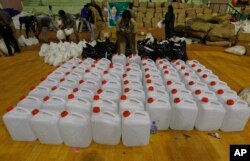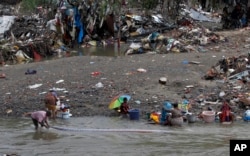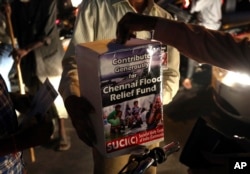There is new scrutiny in India over the vulnerability of sprawling mega cities to natural disasters after floods devastated the southern city of Chennai.
The heaviest rainfall recorded in a century wreaked havoc in Chennai, where the city’s natural drainage system has been impaired by unrestrained construction along river banks and wetlands.
Experts said problems of poor urban planning and rampant development are not unique to Chennai, and are a warning to other cities.
On December 1, Chennai recorded 345 millimeters (13.5 inches) of rain in a 24-hour period.
Prasanth Elango, 22, was fast asleep when water gushed into his ground-floor apartment. "It was full of rubbish and sewage, and three to four dead bodies also came in my friend’s area. ... The water was coming from all the streets,” he said.
Lakes, wetlands filled
With such rainfall, experts said they are not surprised that India’s fourth-largest city turned into a series of islands.
Over the past 15 years, dozens of wetlands and lakes have been filled to build malls, residential areas and business parks in Chennai, a thriving industrial hub and information technology center that is home to more than 6 million people.
Nityanand Jayaraman, a Chennai-based social activist and writer, points out that one of the worst affected areas is Velachery, a thriving residential area that mushroomed on what was once a large lake area after the city’s technology industry boom.
“Between 2005 and 2015, this place has a mass rapid transit system, a railway station that has been constructed upon the marshland," Jayaraman said. "There has been a vast profusion of buildings that have sprouted up over there to accommodate software workers in gated communities, and now we find that most of these things are under water, and most of the software workers have gone back home."
He said the area did not suffer the same fate during heavy rains in 2005 because it was not as thickly populated.
Chennai is not the only city brought to its knees by a heavy deluge.
Ten years ago, the financial hub of Mumbai faced a similar catastrophe after being lashed by 944 millimeters (37 inches) of rain. Last year, Srinagar, the summer capital of Indian Kashmir in the Himalayan mountains, found itself under meters (feet) of water after being deluged by heavy rains.
Unregulated construction
In both cases, urban planners pointed at silting, unregulated construction, and encroachments along lakes and water bodies, which pushed the water into city neighborhoods.
City planners warn that much of the urbanization of India is happening on areas not suitable for construction, such as in flood plains.
Kapil Gupta of the Indian Institute of Technology Mumbai convened India’s first panel on urban flooding, which was set up in the wake of the Mumbai floods.
“There has been unplanned construction and the drainage of these areas has not been planned. Our urban centers need to be protected. We are spending so much on infrastructure, but we need to spend on drainage also and, obviously, we need to leave sufficient path for the rainfall so that our activities are not paralyzed,” Gupta said.
Urban planners are ringing alarm bells as climate experts warn that global warming is likely to result in more extreme weather.
India’s mega cities are already home to millions of people. By 2050, 1 billion people are expected to live in urban areas.
This high-density population would put millions at risk when cities are devastated by flooding.
The Chennai floods have taken a heavy toll -- more than 280 people have died since November and industries have pegged losses at over $20 billion.
Drainage issue
Despite those figures, Shashidhar Reddy, former vice chairman of India’s National Disaster Management Authority, said stormwater drainage remains a low priority for city officials.
"Unlike the roads, which are getting widened to accommodate more traffic, the capacities of the drains have diminished because of encroachments, because of silting, and that is true to every city in India," Reddy said.
He said, on average, the capacity of stormwater drains need to be more than doubled.
After facing colossal losses, Chennai residents are taking action.
More than 50,000 have signed an online petition that calls for the mayor to take up flood relief work and ensure that the city’s drainage problems are addressed.













